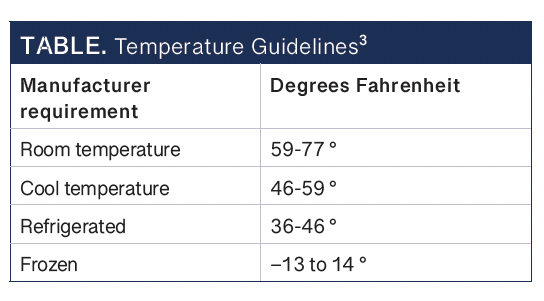Order delivery days often come with a sense of dread for pharmacy staff. Totes of new inventory, which are coming into a pharmacy that is already cramped, must be unpacked and put away so prescriptions can be filled. Not only do pharmacy staff not have the time to do so, but there is often a lack of space in buildings that were never updated to be able to store the thousands of new drugs that have become available in recent decades.
There is much more to safe medication storage, however, than just putting it away. Many factors must be considered, including environment, climate, security, rotation, segregation, and documentation at every step of the way.
Environment
The environment in which medications are stored should be large enough to allow for orderly storage, including proper signage, rotation, and cleaning.1 Sufficient lighting and ventilation are also important parts of medication storage.1 Good lighting is required for choosing the correct medication. Space for ventilation is needed to ensure consistency of temperature while in storage, and this also provides room for cleaning.
Of course, cleanliness is required to keep medications from becoming contaminated. Medications should be kept off the floor, and shelves should be dusted regularly.1 The pharmacy should always be free of dust, dirt, vermin, and insects. If any vermin or insects are found, management should be advised to have an exterminator service the premises.
About the Author
Kathleen Kenny, PharmD, RPh, earned her doctoral degree from the University of Colorado Health Sciences Center in Aurora. She has more than 25 years of experience as a community pharmacist and works as a clinical medical writer based in Homosassa, Florida.
Climate
All medications have storage requirements, such as specific temperature and humidity guidelines, protection from sunlight, and other considerations. Storage requirements help ensure that medications maintain their potency and help reduce the risk of harm to patients. Medication storage requirements may be found on the medication’s label or from a third-party resource.2
Manufacturers must specify the required storage temperature of their products. This may be generalized to room temperature, cool temperature, refrigerated, or frozen. The Table3 provides a guide for temperature management.
The CDC recommends best practices for storing refrigerated medications, including checking and recording the minimum and maximum temperature daily or, if the thermometer does not record minimum and maximum temperatures, checking and recording the temperature twice daily. The CDC also recommends that staff note their initials when documenting temperatures.
Finally, part of these best practices includes acting upon cases of temperature excursions.4 In case of temperature excursions, call the manufacturer of the medication and tell them the length of time the drug has been out of range temperature. They will advise as to how long the product can stay out of range temperature and whether the product can still be used.4
Security
Pharmacy security not only plays a role in inventory safety but is also important to patient safety. Pharmacy security deters theft and robbery while ensuring medications are protected from tampering. By implementing stringent security protocols, including the use of high-quality safes, pharmacies can provide untampered medications to their patients, effectively preventing misuse or abuse.
Pharmacies are required to store their Schedule II medications in a safe. The safe must be Drug Enforcement Administration–approved and locked whenever a medication is not being retrieved or stored. Some safes are time delayed, opening a few minutes after a code is entered. The wait time can feel like an eternity, but this is ultimately a safer way to store Schedule II products.
Medication Rotation
Pharmacies should implement a first-in, first-out inventory management system so that the oldest stock bottle is used first and new stock bottles are placed behind the existing stock bottles. This helps ensure medication is used prior to the expiration date, thereby preventing waste.
Segregation
Drug expiration dates reflect the period during which the product is known to remain stable, which means it retains its strength, quality, and purity when it is stored according to its labeled storage conditions.5 It is important to be aware of the potential harms that may occur from taking an expired medicine or one that may have degraded because it was not stored according to the labeled conditions. If a drug has degraded, it might not provide the patient with the intended benefit because it has a lower strength than intended. In addition, when a drug degrades, it may yield toxic compounds that could cause patients to experience unintended adverse effects. Patients with serious and life-threatening diseases may be particularly vulnerable to potential risks from drugs that have not been stored properly.5
Additionally, pharmacy staff should monitor inventory for recalls and act appropriately when a medication is recalled. Recalled medications are those that are withdrawn or removed from distribution or use for which deficiencies are reported in quality, safety, or efficacy. For these reasons, expired and recalled drugs must be isolated and segregated from pharmacy shelves in a timely manner. These medications must be quarantined in an area that ensures they will not be used until they can be appropriately disposed of.
Although managing storage can be laborious and time-consuming, it is a crucial part of pharmacy management and, ultimately, patient safety. Both pharmacists and pharmacy technicians can play an active role in taking the steps necessary to ensure optimal storage of medications.
References
1. Guideline on good storage practices for pharmaceuticals (GSP). National Medicines Regulatory Authority. August 27, 2021. Accessed April 3, 2024. https://nmra.gov.lk/images/2021/Pharmacy/GL-015-Good_Storage_practices_for_pharmaceuticals_Guideline_final-nmra-finalized_-ee_1_2_1.pdf
2. Safe storage of medications. US Department of Health and Human Services Indian Health Service. Accessed April 3, 2024. https://www.ihs.gov/painmanagement/safestorage/
3. Proper medicine storage in pharmacies is important, and temperature monitoring is the key. TempGenius. Accessed April 3, 2024. https://tempgenius.com/proper-medicine-storage-inpharmacies-is-important-and-temperature-monitoring-is-the-key
4. Temperature monitoring best practices for refrigerated vaccines–Fahrenheit (F). CDC. Updated February 2018. Accessed April 3, 2024. https://www.cdc.gov/vaccines/hcp/admin/storage/downloads/temp-fridge.pdf
5. Expiration dates - questions and answers. FDA. Updated October 24, 2022. Accessed April 3, 2024. https://www.fda.gov/drugs/pharmaceutical-quality-resources/expiration-dates-questions-andanswers








